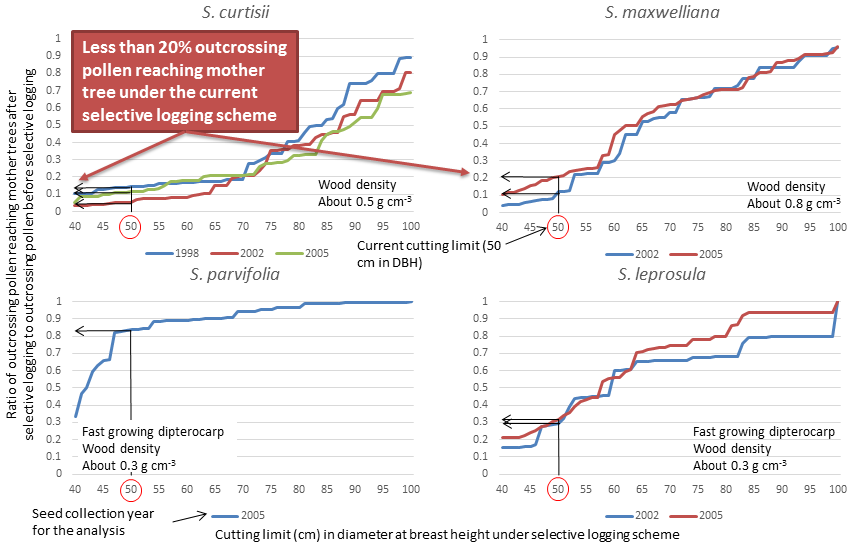Improvement of selective logging criteria for dipterocarp timber species to maintain healthy seed production
Description
Maintaining regeneration is essential for sustainable forest management when products, such as timber, are being extracted. It has been widely believed that the forests have sufficient resilience to recover from selective logging without enrichment planting, and selective logging regimes have been widely applied in sustainable management programs for tropical forests. However, selective logging may also threaten the pollination and sexual reproduction systems of tropical tree species. Consequently, outcrossing restrictions can markedly increase the proportion of unhealthy offspring through inbreeding depression. Thus, selective logging regimes must be optimized in terms of remaining tree density to ensure that healthy outcrossed seeds are produced in sufficient numbers to support the sustainable management of secondary forests.
Parameters of pollen dispersal and flowering intensity were estimated from paternity of seeds collected from mother trees of four focal dipterocarp timber species and a subsequent hierarchical Bayesian model (See JIRCAS Research Highlights 2011, Topic 15). To simulate reductions in outcrossing pollen clouds after logging, we raised the selective logging criterion (cutting limit) in 1 cm increments from 40 cm to 100 cm. At each step, we calculated the amount of outcrossing pollen in the pollen cloud of the mother trees from the remnant trees which were smaller than the arbitrarily assigned cutting limit. However, we applied unified parameter values for every simulation step.
Pollen dispersal patterns of dipterocarps are strongly affected by population density. Thus, as logging inevitably affects population density, it is not realistic to apply the same pollen dispersal kernel parameter estimates following logging at every cutting limit applied in simulations. The unrealistic feature of the simulation should be carefully considered before applying the results in practice. It is still a useful tool to gauge how the reduction in population densities and outcrossing pollen clouds may affect the proportion of healthy outcrossed seeds in selectively logged forests.
The simulation results presented here clearly indicate that outcrossing of S. curtisii is most susceptible, with S. maxwelliana being second most susceptible, to reductions in population density due to selective logging among the four focal dipterocarp species (Fig. 1). These species produce highly durable timber, which could relate to species’ turnover rates, as species with high wood densities have low growth rates, low susceptibility to forest disturbance, and low mortality rates. In addition, the onset of reproduction at relatively large sizes for the species may increase the vulnerability of the pollen dispersal to reduction of population density due to selective logging. The post-logging decline in male fecundity in the remaining small-sized trees as implied in the simulations for S. maxwelliana and S. curtisii, which have highly dense wood, underscores the need for more species-specific cutting guidelines (Table 1). Based on our study, defining groups of timber species according to their wood density could facilitate efforts to formulate selective logging schemes that better balance the exploitation and genetic conservation of dipterocarp timber species.
Figure, table
-
Table 1. Ecological difference between the experimental timber species and improvement plan in response to the simulation results
-
Fig. 1. Simulating the ratio of outcrossing pollen reaching mother trees after selective logging to outcrossing pollen without selective logging for four dipterocarp timber species.The simulation was conducted using the selective logging criterion (tree diameter cutting limit) of 40 cm and at every 1-cm increment thereafter.
- Affiliation
-
Japan International Research Center for Agricultural Sciences Forestry Division
- Research project
- Program name
- Term of research
-
FY2016(FY2011~FY2015)
- Responsible researcher
-
Tani Naoki ( Forestry Division )
KAKEN Researcher No.: 90343798Lee Soon Leong ( Forest Research Institute Malaysia )
Lee Chai Ting ( Forest Research Institute Malaysia )
Ng Kevin Kit Siong ( Forest Research Institute Malaysia )
ORCID ID0000-0002-7810-7575Muhammad Norwati ( Forest Research Institute Malaysia )
Kassim Abdul Rahman ( Forest Research Institute Malaysia )
Musa Samsudin ( Forest Research Institute Malaysia )
Tsumura Yoshihiko ( University of Tsukuba )
KAKEN Researcher No.: 20353774 - ほか
- Publication, etc.
-
Tani N et al. (2016) Journal of Tropical Forest Science, 28: 369-381
https://doi.org/10.1371/journal.pone.0082039Masuda S et al. (2013) PLOS ONE, 8: e82039
Tani N et al. (2012) JIRCAS working report, 76: 61-66
Ecology and Genetics of Hill Dipterocarp Forest : -to aim sustainable forest management-
https://doi.org/10.1111/j.1365-2745.2011.01929.xTani N et al. (2012) Journal of Ecology, 100: 405-415
https://doi.org/10.1093/aob/mcp252Tani N et al. (2009) Annals of Botany, 104: 1421-1434
- Japanese PDF
-
A4 307.46 KB
A3 225.03 KB
- English PDF
-
A4 613.65 KB
A3 616.02 KB
- Poster PDF
-
Poster 447.6 KB

